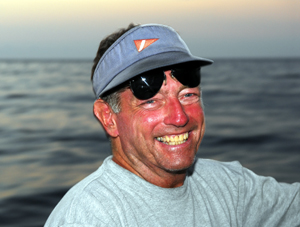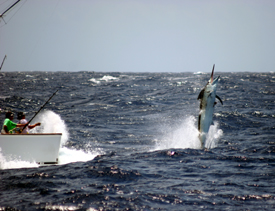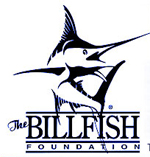TIM CHOATE - A SPORTS FISHING LEGEND IN HIS OWN TIME
 STEWART LOVELAND PHOTO - Tim Choate is one of the lucky ones. He's been able to turn an avid hobby into a lifelong career - and a highly successful one at that with a charter fishing empire that stretches from South and Central America to the Galapagos Islands.
STEWART LOVELAND PHOTO - Tim Choate is one of the lucky ones. He's been able to turn an avid hobby into a lifelong career - and a highly successful one at that with a charter fishing empire that stretches from South and Central America to the Galapagos Islands.
Born to a Hollywood actress and highly successful New York businessman, who divorced when he was ten, Choate fell in love with fishing soon after his mother moved the two of them to the Florida Keys. This was the mid-1950's, when Choate embarked on his warm-weather, out-of-doors lifestyle that saw him fishing in and around the houseboat his mother rented in Islamorada.
He says, "We lived behind McKee's Sunken Treasure Museum. For a kid, it was a dream house. I'd wake up and go fishing."
Though much of his childhood was spent as a student enrolled in St. Mark's Preparatory School, in Massachusetts, Choate says some of his happiest days were flats fishing in Florida. Well-known sports fishermen, such as Capt. Dick Williams and guides Cecil Keith and Ellis Shires saw to his angling education, including turning Choate into a light tackle specialist. But it was Capt. Buck Stark who really fired Choate with what would be his lifelong love - offshore fishing.
Over a ten year period that saw Choate into his teenage years, he and Stark would travel the Caribbean circuit and to Mexico, Cozumel and Isla Mujeres, to fish for marlin and sailfish. No resorts or charter boats operated out of these Mexican destinations in the 1960s, so Choate and Starck hired a trawler and set off on their angling expedition. A few years later, Choate bought a 19-foot outboard and ran it over to Bimini where he and Starck would fish for marlin, perfecting the kite-fishing techniques the elder angler taught him.
In Bimini, Choate met up with Joe Lopez, a fellow member of the Rod and Reel Club in Miami, who expanded his fishing horizons into big game tuna.
During his junior year in college at the University of Miami, Choate met Mark Phillips, the oldest son of Striker Yachts founder Herb Phillips. After a year off to travel the world and fish, then a three-year law school education and stint working at the Dade County state attorneys office with Janet Reno prosecuting drug traffickers and other lowlifes, Choate kept up his friendship with Phillips and continued his fishing forays to locations such as Cozumel and St. Thomas to fish major tournaments. Although he didn't travel with the Striker team sword fishing to Chile, his association with Striker did enable him to make important fishing contacts with top captains such as Ronnie Hamlin, Peter B. Wright and Skip Smith.
The 1970s brought changing fortunes due to the oil crisis and Phillips and his father asked Choate to help bail out Striker Yachts. He did so as the CEO of the struggling company, thus leaving behind law in favor of the boat business. He gave it his best shot, but still Striker went under. On the upside, Choate gained a large tract of waterfront land in Fort Lauderdale. Today, this is the Artmarina Inc., realm where some 30 marine repair warehouses are located. The name is play on Choate's legal first name, Arthur.
 At the end of the 1970s, Choate traveled to fish the Great Barrier Reef. The adventure earned him both a catching and carousing reputation. For example, while fishing with Capt. Peter B. Wright, he caught a 1,210-pound marlin that went down in the history books as one of the biggest fish hooked for the year. At the same time, Choate impressed the free-spirited Aussies by his ability to party all night and fish all day. "Always remember," he says, "that the size of the fish you catch is directly proportionate to the amount of booze you consume while angling."
At the end of the 1970s, Choate traveled to fish the Great Barrier Reef. The adventure earned him both a catching and carousing reputation. For example, while fishing with Capt. Peter B. Wright, he caught a 1,210-pound marlin that went down in the history books as one of the biggest fish hooked for the year. At the same time, Choate impressed the free-spirited Aussies by his ability to party all night and fish all day. "Always remember," he says, "that the size of the fish you catch is directly proportionate to the amount of booze you consume while angling."
Choate dreamed of mounting a worldwide fishing campaign, but didn't have the big bucks necessary. So, he astutely came up with and launched a grand plan: He sent paying customers to fish on his buddies sports fishing boats as they traveled to some of the top fishing destinations in the world in swap for some personal days of angling for himself. "It was an offshoot of the leasing and supply business I'd been developing as part of Artmarina," he says.
Business squared away, Choate was ready to get into some serious fishing. So in 1983, he got himself hired as second mate aboard Escapade and working with Capt. Mike Aman and Chester Jenkins, planned to become the fist boa ever to land 1,000 billfish in a calendar year. "It took just 900 hours and 115 fishing days to catch-and-release 1,108 billfish. That's a 15.2-fish-per-day average," says Choate, who acted as scorekeeper.
Their journey is one for the record books as well. It took them to Florida, the Bahamas, Mexico, Virgin Islands and Venezuela, and back. They caught nine grand slams and the first-ever back-to-back super grand slam.
It was by no accident that Choate released all the fish he caught. In addition to being a renaissance fisherman - owner, angler and mate, and sharing his special fishing spots with by offering charter boats, he's also become quite a fighter for fisheries around the globe. Today, Choate has earned quite a reputation for billfish conservation in Central and South America. For example, he required all his charter captains to switch to circle hooks back in 1998, long before they were proved to be a statistically better alternative to J-hooks. As a result, Guatemala and Costa Rican governments have enacted laws requiring all billfishermen to use circle hooks. Choate also spurred the government of Costa Rica, with the added oomph of the Costa Rican Ecological Watch - a organization he formed with a group of local fishermen and ecologists - to ban the killing and sale of sailfish.
In the meantime, the sports fishing sailfish action off the Central American coast was heating up and gaining a hot reputation with international anglers. In response, Choate set up fishing lodges. "The whole thing started out being self-serving. I figured out the best way for me to fish as much as I wanted was to work as a mate. But, I soon saw how little time actually is left for fishing on these trips. Instead, a lot of time was spent planning, provisioning and getting to each location. It seemed to be that the only way to get the best of both worlds, the worlds of a land-based lodge versus a traveling mother ship, was to set up a couple of fishing bases from which you could operate after moving the boats a few hundred miles as the fish migrated."
Magic, Choate's 31-footer run by Capt. Brenden Burke, became the first boat to catch more than two grand of billfish in a single year. Since 1990, the boat has caught-and-released more than 20,000 billfish, making it the most successful billfishing vessel in history. The Magic is still part of Choate's fleet at the Fins 'N Feathers resort in Iztapa, Guatemala.
 Since then, Choate has set up operations in Brazil and has now turned his sights to the Galapagos. "It's a great fishery," says Choate, "but it's been a tough road getting the park officials to realize that sports fishing isn't commercial fishing.
Since then, Choate has set up operations in Brazil and has now turned his sights to the Galapagos. "It's a great fishery," says Choate, "but it's been a tough road getting the park officials to realize that sports fishing isn't commercial fishing.
Note - Tim and friend Win Rockefeller were the pioneers of The Billfish Foundation (TBF). Hats off to Tim for his efforts to better the sport of big game fishing. JL
